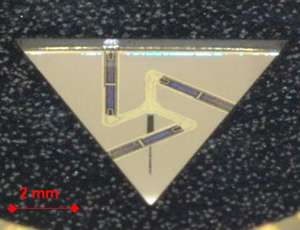Mini robot builds NPL probe

Precision engineering requires accurate measurements and these are often made using co-ordinate measuring machines, or CMMs.
The measurements need to be, at the very least, of equal accuracy to machining capabilities, especially when working with small components with functional micro-scale features. While some new micro-CMMs are capable of making such accurate measurements, many existing probing systems lack the functionality to do so.
To address this, NPL has developed a novel micro-scale CMM probe that aims to reduce the measurement uncertainty of micro-CMMs to below 100 nanometres (or 0.0001 millimetres). The probe consists of a three-legged flexure device and a micro stylus with a spherical tip.
Each flexure is 2 mm long, 0.2 mm wide and around 0.02 mm thick. The stylus is 2 mm long and 0.2 mm in diameter with a 0.07 mm diameter spherical tip.
The probe is a MEMS device (micro-electrical mechanical system). It has built-in piezoelectric film coated onto the flexures so they act as sensors and actuators, allowing the device to vibrate away from measurement surfaces and counteract surface forces that are very strong at these tiny distances. The vibration also allows the probe to operate in non-contact mode.
To assemble such a device there is a need for high-precision, repeatability, flexibility and low cost, as well as a workspace that takes up as little room as possible. In order to meet these demands, a miniaturised assembly setup using a robot called Parvus (which is Latin for 'small') was constructed. The robot was built at the Technische Universität Braunschweig, Germany, to function as a mini industrial production robot, to demonstrate the possibility of reducing the size of assembly lines and realising a 'desktop factory'.
The video below, put together by TU Braunschweig, shows the assembly process:
More information: View a poster on the CMM probe
Provided by National Physical Laboratory




















